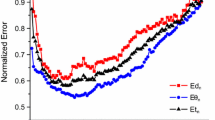Abstract
Electrocardiographic inverse solutions frequently assume multiple-dipole equivalent generators with locations fixed throught the QRS complex. This paper describes investigations which extend the solution to optimise the dipole locations at any instant of time. The combined results lead to a moving multiple-dipole inverse solution which is more accurate than the conventional solutions at each instant and also contains information related to the dynamic movement of the physiological generators. Tests so far have been limited to a 3-dipole solution in a highly simplified torso model. The generators in this study were dipoles displaced varying amounts from a standard central location; the inverse solution starts by using the standard location and then is led to an improved solution by a guided search. Moderate displacements, as compared to the size of the heart model, were shown to yield root mean square errors in the inverse-solution source strengths as high as 40% when the latter were found via a least-mean-square procedure. The method of steepest descent was utilised in the second step to improve the locations and strengths of the initially assumed equivalent-dipole generators and thus improve the accuracy of the inverse solution. The percentage root-mean-square source-strength errors were reduced from as high as 40% to under 10% in most cases. The initial position error of up to 10% for the source dipoles typically was reduced to less than 5% throught the use of the search routine. The ability of the solution dipoles to track the original locations was demonstrated.
Similar content being viewed by others
References
Baldwin, A. F., III (1976) Reduction of positional errors in the inverse solution in electrocardiography. Unpublished MSc Thesis, University of Vermont.
Baldwin, A. F., III andRush, S. (1976) An optimization procedure for fixing the locations of multiple dipole heart generators. Proceedings of the 29th Conference of the Alliance for Engineering in Medicine & Biology18, 12.4.
Barr, R. C., Pilkington, T. C., Boineau, J. P. andSpach, M. S. (1966) Determining surface potentials from current dipoles, with application to electrocardiography.IEEE Trans. BME-13, 88–92.
Barr, R. C., Pilkington, T. C., Boineau, J. P. andRogers, C. L. (1970) An inverse electrocardiographic solution with an on-off model.IEEE Trans. BME-17, 49–57.
Bellman, R., Collier, C., Kagiwada, H., Kalaba, R. andSelvester, R. (1964) Estimation of heart parameters using skin potential measurements.Commun. ACM,7, 666–668.
Denn, M. M. (1969)Optimization by variational methods. McGraw-Hill, New York, 52–61.
Gelernter, H. J. andSwihart, J. C. (1964) A mathematical-physical model for the genesis of the electrocardiogram.Biophys. J. 4, 285–301.
Geselowitz, D. B. (1965) Two theorems concerning the quadrupole applicable to electrocardiography.IEEE Trans. BME-12, 164–168.
Harrington, R. F. (1958)Introduction to electromagnetic engineering. McGraw-Hill, New York, 188–224.
Helm, R. A. andChou, T. C. (1969) Computation of a variable dipole representation from body surface leads.Am. Heart J. 77, 363–366.
Holt, J. H., Barnard, A. C. L. andLynn, M. S. (1968) A study of the human heart as a multiple dipole electric source. II—Diagnosis and quantitation of left ventricular hypertrophy.Circulation Res. 11, 711–718.
Holt, J. H., Barnard, A. C. L. andLynn, M. S. (1969) A study of the human heart as a multiple dipole electric source. III—Diagnosis and quantitation of right ventricular hypertrophy.Circulation Res. 11, 711–718.
Horan, L. G. andFlowers, N. C. (1967) Simulation of the sequence of ventricular activation and the choice of an inverse solution.Med. Res. Eng. 6, 28–35.
Lynn, M. S., Barnard, A. C. L., Holt, J. H. andSheffield, L. T. (1967) A proposed method for the inverse problem in electrocardiology.Biophys. J. 7, 925–945.
Lux, R. L., Smith, C. R., Wyatt, R. F. andAbildskov, J. A. (1978) Limited lead selection for estimation of body surface potential maps in electrocardiography.IEEE Trans. BME-25, 270–276.
Miller, W. T., III (1974) The inverse problem of electrocardiography using electric and magnetic data. Unpublished MSc Thesis, Pennsylvania State University.
Rogers, C. L. andPilkington, T. C. (1969) Freemoment current dipoles in inverse electrocardiography.IEEE Trans. BME15, 312–323.
Rush, S., Turner, A. H. andCherin, A. H. (1966) Computer solution for time-invariant electric fields.J. Appl. Phys. 37, 2211–2217.
Rush, S. (1975) An inhomogeneous anisotropic model of the human torso for electrocardiographic studies.Med. & Biol. Eng. 9, 201–211.
Rush, S. (1975)An atlas of heart-leads transfer coefficients. University Press of New England, New Hampshire.
Rush, S. andBaldwin, A. F. III (1976) Some quantitative estimates of inhomogeneity effects in electrocardiography.Am. Heart J. 91, 623–633.
Schneider, M. R. (1972) A multistage process for computing virtual dipolar sources of e.e.g. discharges from surface information.IEEE Trans. BME-19, 1–12.
Stark, P. A. (1970)Introduction to numerical methods. MacMillan, London, 319–327.
Taccardi, B. (1963) Distribution of heart potentials on the body surface of normal human subjects.Circulation Res. 12, 341–352.
Author information
Authors and Affiliations
Additional information
Part of these results were presented earlier (Baldwin and Rush, 1976)
Rights and permissions
About this article
Cite this article
Baldwin, A.F., Rush, S. Optimisation of the locations of multiple-dipole heart generators in a simple torso model. Med. Biol. Eng. Comput. 17, 569–577 (1979). https://doi.org/10.1007/BF02440901
Received:
Issue Date:
DOI: https://doi.org/10.1007/BF02440901




